Last updated: October 23, 2023
Article
2022 Science and Stewardship Highlights
Our parks are places where the distance between today and the past thins, and we can examine the triumphs and shortfalls of our ancestors while standing in their footsteps. Conserving our nation’s rich cultural heritage – the stories, places, traditions, and artifacts that make up the fabric of our shared history – is an important part of the National Park Service (NPS) mission. In the National Park of the American Samoa, park managers are learning from the Samoan community, researching their traditional ecological practices to be better co-stewards of the land.
The people doing this work across the Pacific West Region are a diverse cohort: from a Mexican Ph.D. candidate studying flowering plants and bees on the Channel Islands, to a fellow preserving historic photos in Mount Rainier’s archives, and the Yurok Tribe restoring California Condors to their ancestral lands in Redwood National and State Parks. These individuals are ensuring that the scientific community is inclusive to people of all backgrounds.
Building the Bridge: Steps Toward Integrative Resource Management
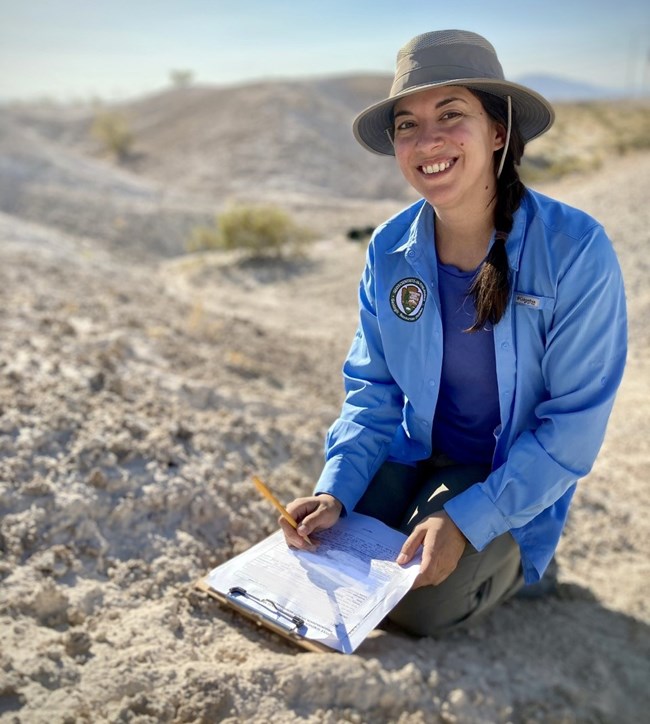
NPS / Lauren Parry
Fighting Erosion in the Sands of Time at Tule Springs Fossil Beds National Monument
Tule Springs Fossil Beds National Monument preserves thousands of Ice Age fossils that tell a story of extinction, survival, global climate changes and spring activity over time. Although this 22,000-acre fossil site in Las Vegas, Nevada has boundless potential for research and discovery, its fossils are highly vulnerable to natural and human-caused threats, such as erosion and vandalism. Fossil sites are given low, medium, and high priority values to assess vulnerability and help create a schedule for how often site monitors visit. Park staff and trained volunteers partake in the paleontological site monitoring program at the park to accurately document and preserve fragile fossil resources and the stories they tell for generations to come.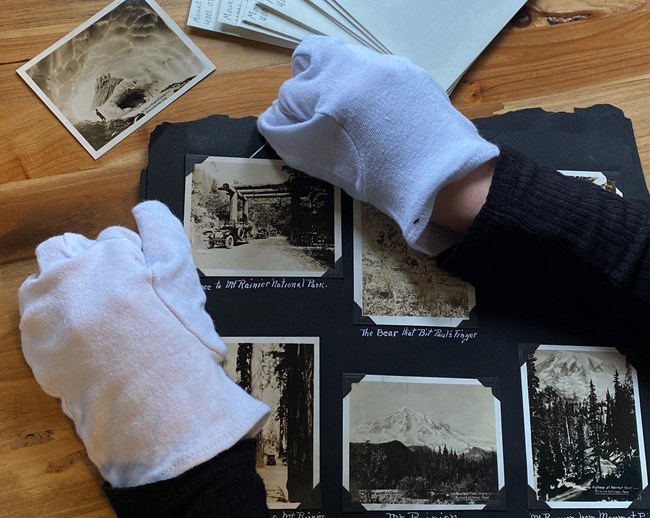
NPS / Emma Rockenbeck
The Bear that Bit Paul's Finger at Mount Rainier National Park
Parks like Mount Rainier National Park are harnessing modern technology to preserve their archival collections. By meticulously scanning photographic and paper records, national parks are expanding public access to the nation’s history and limiting the exposure and damage of priceless cultural resources. Park staff and volunteers often uncover surprising stories along the way. Emma Rockenbeck is a Workforce Management Fellow at the Pacific West Regional Office who volunteers with Curatorial Facilities at Mount Rainier National Park. While scanning photos from an old park scrapbook, Emma came across evidence of an age-old problem at national parks: visitor interactions with wildlife. These curatorial records provide glimpses into the recreational history of Mount Rainier over time.Creating Cultural Connections
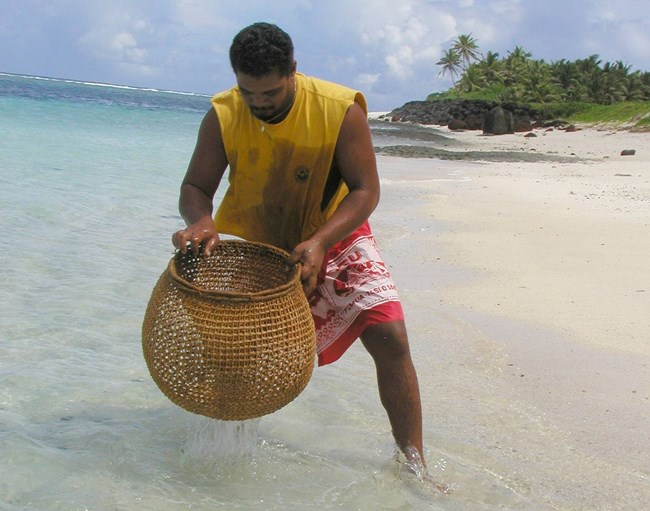
NPS
Window to the Past – Valuing Samoan Traditional Knowledge
For three millennia, the Samoan people built an extensive knowledge base of how to manage their lands and ocean waters. Maintaining traditional use and access to these resources by the Samoan community is critical for a thriving environment and culture. However, social, political, and environmental changes have impacted traditional access to park resources over time. A recently completed Traditional Use Study at National Park of American Samoa hopes to reverse that trend. The information that is gathered in the study will help the park manage its natural resources for culturally and environmentally sound decisions. Honoring this traditional knowledge will also allow the park to strengthen its relationship with the Samoan community and lay the foundation for collaboration in the future.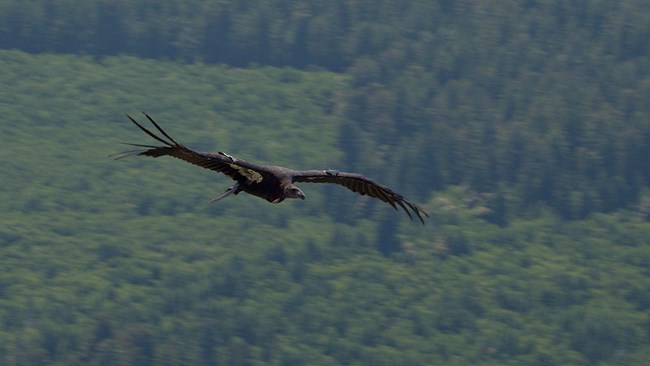
Will Goldenberg
Condors Return to Redwood National and State Parks and the Greater Yurok Ancestral Territory
California condors, North America’s largest birds, are once again soaring over North America’s tallest trees in northern California. Yurok Tribe members approached park managers with a vision and plan for restoring these culturally significant animals to the area in 2008. 2022 marks a significant year in this longstanding effort, as NPS staff and tribal partners released eight birds through a co-managed effort between March and November. The release comes after a century of condor-absent skies in the region primarily due to lead poisoning from ammunition the birds encountered in shot animals. Program managers hope to release four to six condors annually in the park and greater Yurok Ancestral Territory for the next 20 years.Stories of Discovery and Innovation

NPS / Greg Stock
In John Muir's Footsteps: Studying Glaciers at Yosemite National Park
Yosemite’s Lyell and Maclure glaciers are among the longest studied glaciers in North America. On August 21, 1872, naturalist John Muir installed stakes in the Maclure Glacier and returned 47 days later to find that the stakes moved an inch per day. Both the Lyell and Maclure glaciers have been steadily retreating since they were first mapped and photographed in 1883, but melting has accelerated rapidly in the past decade. In 2022, park scientists reproduced Muir’s experiment 150 years ago to the day on Maclure and Lyell Glaciers, which have lost 90% of their 1872 volumes. They found that Maclure Glacier has slowed, creeping at about half an inch per day, and that the Lyell Glacier did not move. Monitoring glacier movement provides an important link to understanding how a glacier changes over time in mass and makeup. Soon to disappear, these glaciers are among Yosemite's most visible indicators of climate change.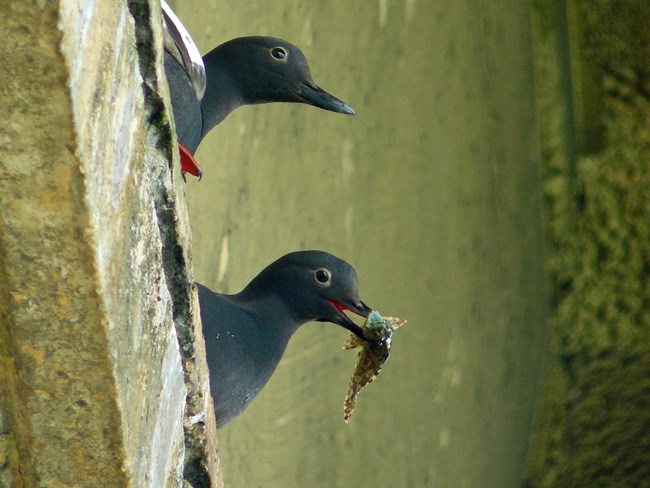
NPS / Laura Young
Alcatraz: Once a Prison, Now a Sanctuary for Breeding Seabirds
Warming ocean waters off the coast of California appear to be disrupting marine organism populations that seabirds feed on. The instability of food resources in ocean foraging locations ultimately affects offshore seabird breeding success. Meanwhile, Alcatraz Island, located within the San Francisco Bay estuary, may offer seabird colonies more stability. NPS Natural Resource Specialist Victoria (Tori) Seher led a new study on pigeon guillemots on Alcatraz and Southeast Farallon Island to support the idea that nearshore environments offer breeding seabirds a valuable habitat alternative. As offshore conditions become more variable, estuary sites near Alcatraz may become more important than ever to the success of pigeon guillemots and other seabird populations at a regional scale.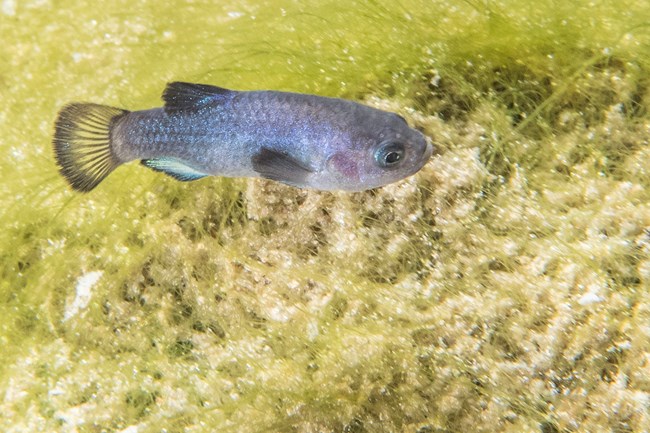
NPS / Brett Seymour
What's up with the Devils Hole Pupfish?
Known for being the lowest and hottest place in North America, Death Valley National Park is the suprising and only naturally occurring home of an endangered fish. The Devils Hole pupfish lives in Devils Hole, a small water-filled cave system within the park. Before the 1990s, the population waivered around 400-500 pupfish. However, population numbers have been especially low during the last two decades, averaging only 90 fish with an all-time low of 35 fish in the spring of 2013. Biannual population estimates in 2022 showed promise with counts of 175 in the spring and 263 in the fall. This is the largest population scientists have seen in two decades! These numbers are exciting as Devils Hole pupfish are one of the world’s rarest fish. Scientists at Death Valley National Park continue to track the population size to understand how ecosystem conditions, such as water level, impact the overall well-being of the species.
NPS Photo
Creating Portable Air Monitors for Protection
Sequoia and Kings Canyon National Parks (SEKI) experienced significant smoke impacts in 2020 and 2021 due to high severity wildfires. Smoke is monitored as PM2.5 (particulate matter that is 2.5 micrometers and smaller) using devices such as Purple Air (PA) monitors. The data from these monitors are immediately available to the public and employees. However, the current PA monitors are only operational in areas with a strong Wi-Fi connection and a reliable power source. Because of these limitations, staff are unable to monitor PM2.5 concentrations in any of the backcountry or wilderness areas of the park where they work in the summer. To resolve this problem, NPS Air Resources Division partnered with SEKI to engineer and adapt PM monitoring devices, so they can remotely operate without power and Wi-Fi service. It is imperative that SEKI monitor smoke concentrations throughout the wilderness areas to ensure employees out in the field have safe working conditions and overall health and wellness.For more information, contact Tony Prenni or Erik Meyer
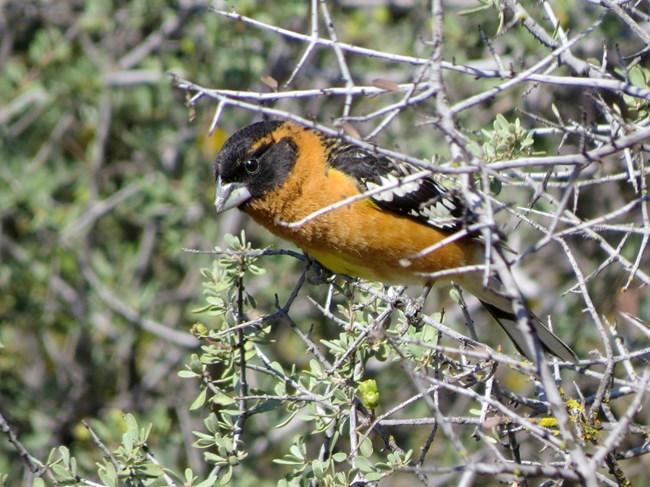
© Garth Harwood / Photo 32552464 / 2016-04 / iNaturalist.org / CC BY
Three Parks Collaborate to Manage Migratory Species in the Face of Climate Change
Scientists have abundant, worldwide data on non-migratory bird population trends and climate change impacts on their habitats. This makes it easy to understand how climate change affects birds who stay in one place year-round. However, the existing data isn’t enough to tease apart how changing climates affect migratory birds at different stages of their annual journeys. In response, scientists at Golden Gate National Recreation Area, Yosemite National Park, and Point Reyes National Seashore are GPS tagging black-headed grosbeaks to study how climate change impacts their molting habitats. This study can serve as a model to understand when and where other migratory species may be more vulnerable to climate change, taking migratory bird studies to a new level.The Friends We Made Along the Way: Science Through Collaboration
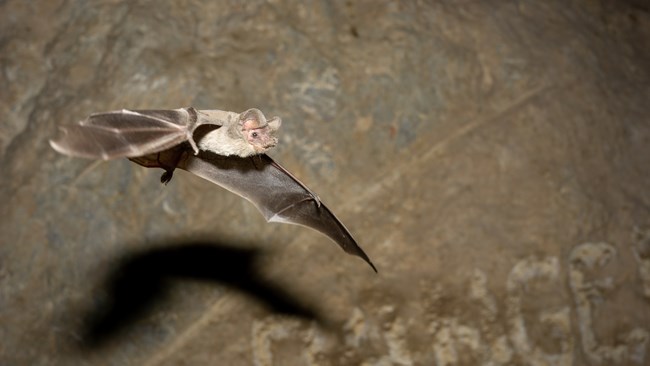
NPS / Joseph Danielson
Bats Beyond Borders at Great Basin
Mexican free-tailed bats are one of the most abundant mammals and efficient predators in the North American night sky. These bats provide benefits to ecosystems and people by consuming huge numbers of insects each year, including many that damage crops and wild plant communities. These predators face unprecedented threats such as drought, habitat loss, and wind energy development. To better understand and potentially mitigate these threats near parks, biologists at Great Basin National Park are teaming up with experts from Nevada Department of Wildlife, Christopher Newport University, and many volunteers to study changing demographics and habitat use at a maternity colony within the park. Data collected will feed into conservation strategies for Mexican free-tailed bats in Nevada and beyond.
Golden Gate National Parks Conservancy
San Mateo Fine Scale Vegetation Map Complete at Golden Gate National Recreation Area
After four years of hard work, a coalition of agencies and partners, including Golden Gate National Recreation Area, completed a fine scale vegetation map of San Mateo County and federal lands in San Francisco. These maps are precise snapshots of plant communities (and other land cover types) across a landscape at a given time. The map produced by this team identified 106 land cover types, including 82 vegetation communities. An extraordinary 97,582(!) polygons were mapped and make up the colorful puzzle that depicts the landscape. The detailed vegetation map is an invaluable tool for local land stewards that helps identify areas for fuel reduction efforts and conservation priority.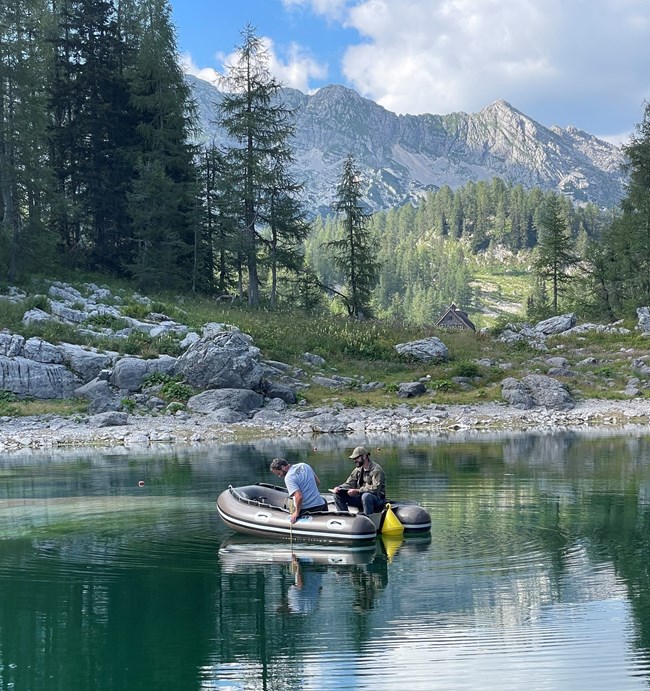
Violet Hering
Crater Lake National Park Collaborates with Sister Park in Slovenia to Restore Alpine Lakes
Crater Lake National Park and its sister-park Triglav National Park in Slovenia each protect mountain ecosystems with diverse aquatic habitats such as streams, wetlands, ponds, and large lakes. In both parks, invasive species threaten native aquatic fauna. In 2019, Crater Lake’s aquatic ecologist Dave Hering helped the Slovenian park restore alpine lakes altered by nonnative fish. There, he met with international colleagues to share expertise on nonnative species removal and environmental DNA (eDNA) techniques used to document species’ presence in an environment. In the summer of 2022, Dave returned to Slovenia as a Fulbright Specialist to continue this field project and record the reduction in nonnative eDNA after exotic fish removal. Dave’s work shows how eDNA techniques used in the United States can also be an effective in other countries to help restore and conserve alpine lakes.Forging the Future with Youth and Volunteers

California Academy of Sciences / Chris Wemmer
Tracking the Reclusive Mountain Beaver at Point Reyes National Seashore
Caroline Champlin, a volunteer researcher with the University of California at Berkeley is leading a collaborative project with Point Reyes National Seashore to survey the peninsula for burrows of the elusive mountain beaver. Contrary to their name, mountain beavers do not build dams, nor do they have flat paddle-shaped tails. In fact, they’re not even beavers! Mountain beavers are the world’s most primitive living rodent, and it looks something like an oversized gopher. Point Reyes National Seashore hosts a subspecies of mountain beaver found nowhere else in the world. Spotting one can be tricky because they spend most of their time in underground burrows, leaving only to forage for plants. Caroline is working with NPS biologists to better understand the distribution and abundance of this subspecies in the park. Ultimately, this research will guide management practices, particularly for wildfire preparedness, to protect this unique species.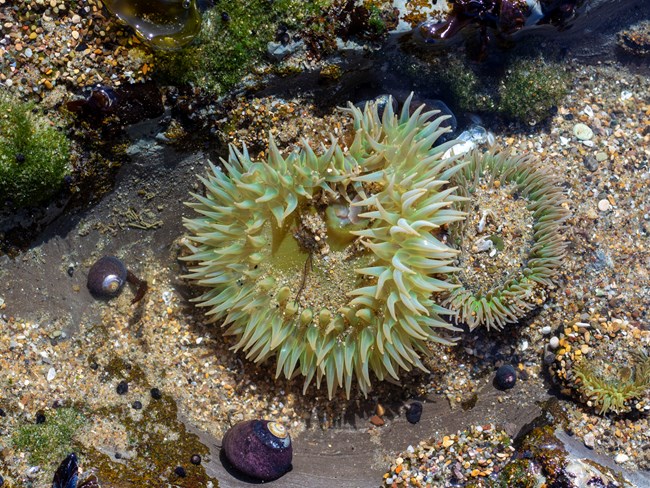
NPS / Environment for the Americas / Jailyn Hoskins
A Zone of Its Own - Adventures in Rocky Intertidal
Standing at the rocky shoreline between the land and the sea, Jailyn Hoskins pores over crevices looking for life between the tides. “I saw colorful claws from a few crabs, who seemed to be happy to be getting some sun. I knew the intertidal stole my heart when I saw a baby ochre star nestled beside a much larger purple ochre star. There were also anemones smaller than quarters, and some larger than my hand!” Jailyn was a Mosaics in Science intern over the summer who assisted ecologists at Golden Gate National Recreation Area and Point Reyes National Seashore with the parks’ long-term rocky intertidal monitoring program. Monitoring helps researchers track changes in species diversity, distribution, and abundance to understand the impacts that disease, oil spills, climate change, and ocean acidification have on tidepools. Jailyn’s experience is just one of many from dedicated NPS interns that contribute to the program’s rocky intertidal dataset.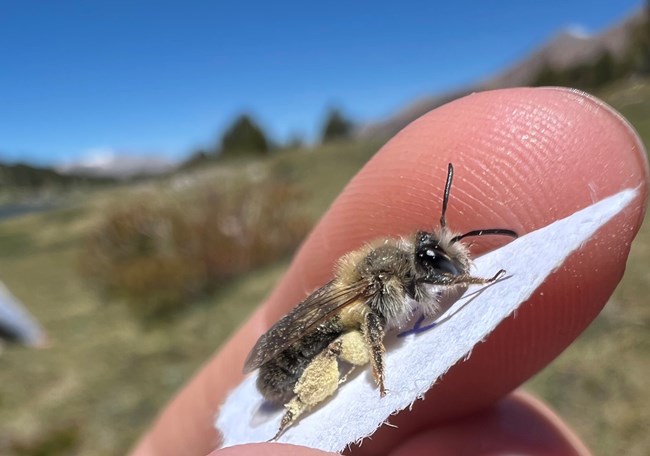
NPS / Scientists-In-Parks / Elizabeth Rush
Yosemite Pollinator Hotshots
The Yosemite Pollinator Hotshots is a program that collaborates with researchers from Colorado State University to provide natural resources and science experiences for minority groups through pollinator studies. Pollinators are a critical part of our ecosystems and populations are experiencing startling declines worldwide. Biologists need to understand what is driving the decline to develop effective conservation plans. Using iNaturalist, the Hotshots documented the distribution and abundance of a variety of pollinators including bees, butterflies, and hover flies, at 20 sites spread across all ecosystems in Yosemite. The data the Hotshots collected will help ensure that park restoration efforts are effective in protecting pollinators and contribute to resilient ecosystems.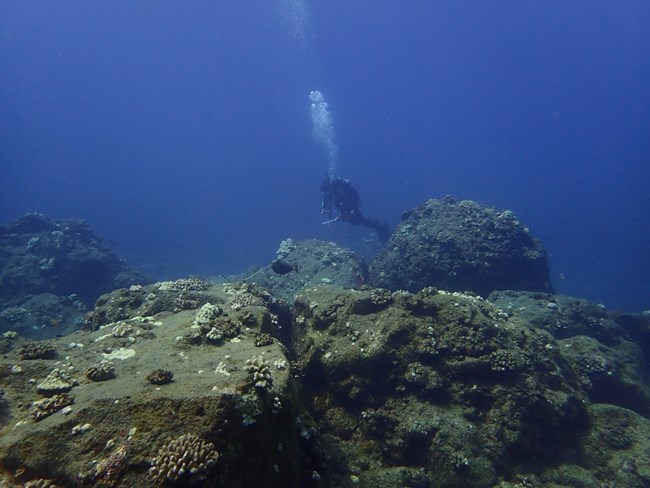
Our World Underwater Scholarship Society / Hailey Shchepanik
Submerged Resources: Discovering Our Underwater National Parks
Did you know that 61 NPS areas have submerged or underwater resources? Hailey Shchepanik is an intern with the NPS Submerged Resources program that works in collaboration with Our World Underwater Scholarship Society, a program that supports the location, documentation, interpretation, and preservation of underwater resources in National Parks. In 2022, Hailey dove at nine different parks for projects such as biological assessment of resilient coral reefs in American Samoa, underwater archeology of the USS Arizona in Pearl Harbor, invasive species monitoring in the depths of Crater Lake, and surveys of endangered Hawaiian monk seals at Kalaupapa National Historic Park. Her work continues the program’s legacy of providing valuable knowledge of our vast underwater resources and bringing that knowledge to the forefront of conservation management and public education efforts.The Head Under the Hat
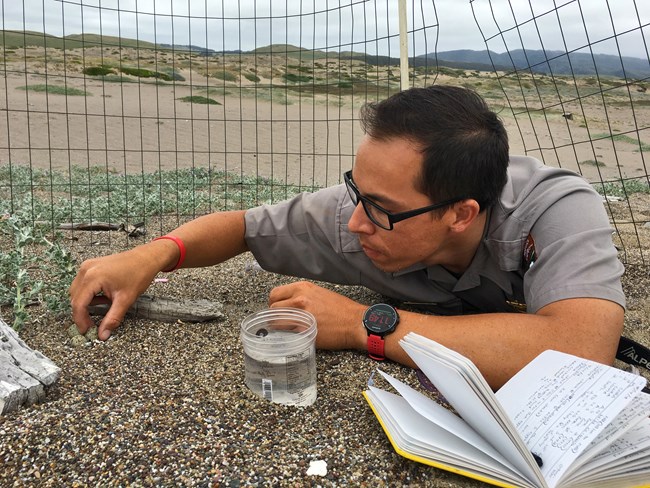
Point Reyes National Seashore Association / Joey Negreann
Birds, Beaches, and a Biologist…Oh My! A Day in the Life of a Wildlife Biologist at Point Reyes
“Being a wildlife biologist is pretty awesome” says Matt Lau at Point Reyes National Seashore. Matt walks long distances on the beaches at the Seashore almost every day between March and September to study federally threatened Western snowy plovers, a keystone beach forager. His task is to better understand the population's reproductive success each year, particularly in relationship to local management actions such as restoration of dune plant communities and mitigation of plover chick predation by ravens. Matt describes his work as “type 2 fun,” meaning it's difficult in the moment but rewarding after. The life of a wildlife biologist can be especially gratifying after attending a nest hatch, devoting several days to monitoring the chicks, and seeing them grow up and fledge. Matt's work will help NPS continue to refine management of plover habitat to facilitate Western snowy plover recovery.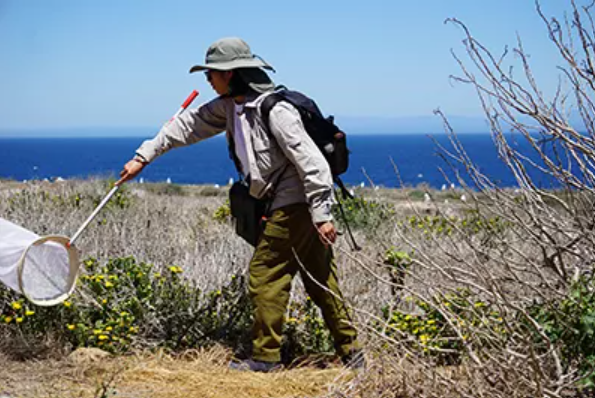
NPS / Magda Argueta-Guzmán.
A Mexican Scientist’s Reflections on Diversity in Nature and Science
On a windswept bluff at Channel Islands National Park, a net comes down on a flowering shrub. Magda Argueta-Guzmán, a Ph.D. candidate at the University of California in Riverside, is studying how the composition and diversity of plant, bee, and bee gut microbial communities all influence one another. Being isolated from the mainland for thousands of years, the islands are a unique research laboratory for those interested in island biogeography and endemism. Magda also advocates for an inclusive scientific community and co-founded Insects4Inclusion, a project that reduces the economic barriers for historically excluded groups of students by providing paid research internships.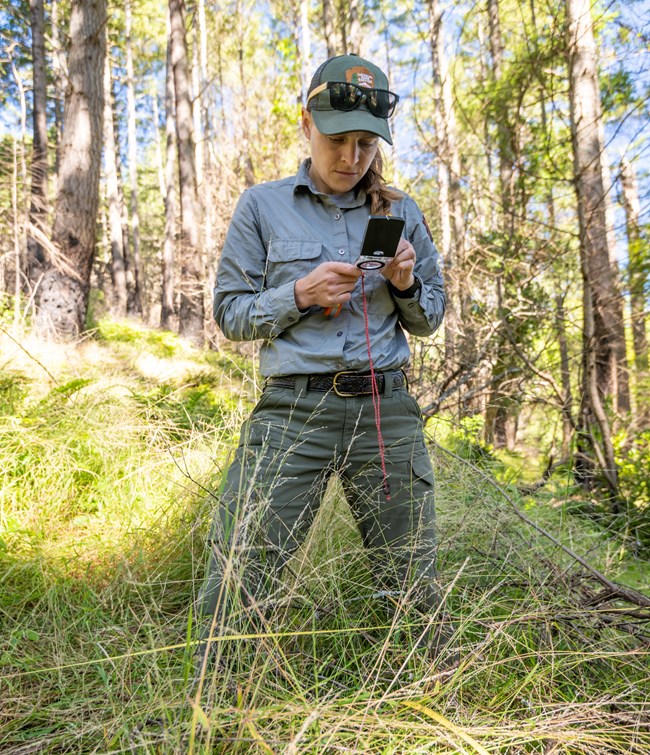
NPS / Jessica Weinberg McClosky
Botanizing around the Bay with Lisa Schomaker
Lisa Schomaker is a botanist for the San Francisco Bay Area Network of parks and the lead for two long-term monitoring efforts that assess native and nonnative plants in the area. Lisa studies and monitors plant communities such as redwood forests, oak woodlands, and coastal scrubs, to look at community trends over time. She also helps the NPS detect new invasive plant populations for eradication to protect the Bay Area’s outstanding and diverse flora. Park managers use this work to mitigate threats to plants and wildlife and plan for a changing future. One of the best parts of Lisa's job is mentoring the next generation of botanists through the Scientists-In-Parks program and helping them create a monthly botany newsletter that highlights local species and stories from the field.Nimble Action to Address Emerging Issues

NPS
Joshua Tree National Park’s Think Tank on a Shoestring
Parks often face unprecedented problems related to climate change, visitation, and resource degradation. Opportunities for creative thinking to find innovative solutions and tackle these problems are often hampered by lack of funds and time. In a recent win, Joshua Tree National Park staff leveraged a number of resources including year-end funding, willing participants, and complimentary lodging to engage the right facilitator and host a brainstorming workshop on the fate of Joshua trees. Results and unexpected side products include a climate futures analysis by Dave Lawrence of the NPS Climate Change Response Program, a list of prioritized research needs and stewardship actions, "crowd sourced" seed viability testing, and strengthened relationships with partners working on Joshua tree refugia research and protection.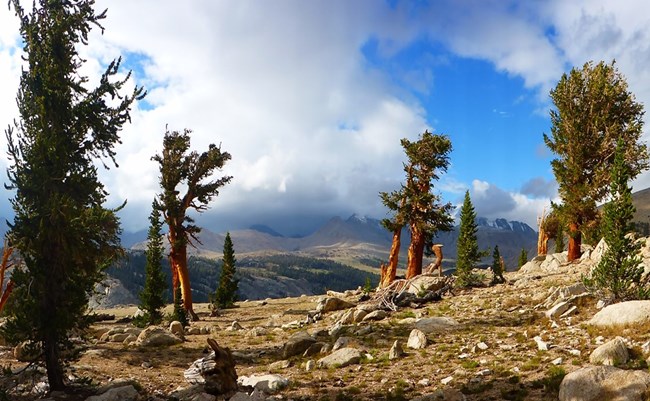
NPS / R. Kessler
Tracking Whitebark Pine Mortality in Sierra Nevada Parks
Whitebark pine is a dominant tree in Rocky Mountain and Sierra Nevada subalpine habitats. Due to its decades-long decline, the federal government listed the pine as a threatened species under the Endangered Species Act in December 2022. While mass mortality events have occurred in the northern portion of its range, the southernmost populations in the Sierra Nevada have remained largely intact. However, growing anecdotal evidence suggests emerging, widespread die-off of whitebark pine within Kings Canyon National Park. In 2022, ecologists with the Sierra Nevada Inventory and Monitoring Network and the US Geological Survey found die-off in whitebark pine as well as in foxtail pine, an iconic long-lived white pine endemic to the Southern Sierra. These trees are known for their remarkable age and ability to survive adverse conditions. Rapid changes across both species suggest the beginnings of a mortality wave event in the subalpine. These findings call out the urgent need for ongoing assessment and restoration efforts throughout the western mountains.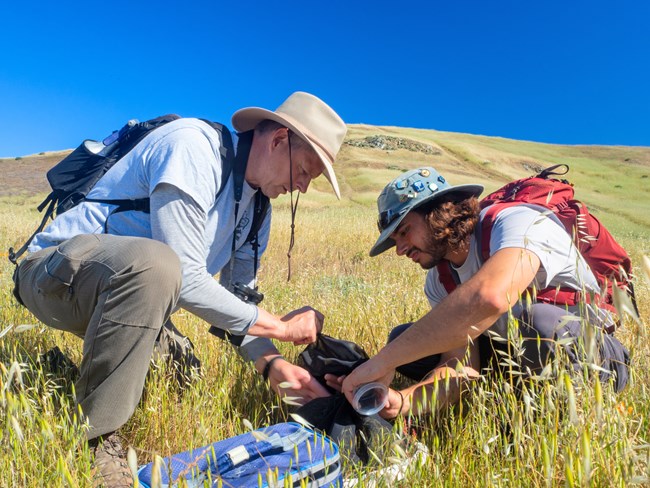
NPS / Eric Wrubel
Mission Blue Butterflies Fly Again in Golden Gate National Recreation Area
A multi-agency collaboration is bringing mission blue butterflies back to Sweeney Ridge in Golden Gate National Recreation Area, one of the few remaining places in the San Francisco Bay Area supporting these endangered butterflies. The quarter-sized, iridescent insects disappeared from the site in the 1980s after a fungal outbreak decimated their lupine host plants. Now, thanks to the grassland enhancement and butterfly translocation efforts of project staff, mission blues are flying there again for the first time in 35 years! These endangered insects only survive in a few places within the Bay Area. Adding another geographically distinct mission blue sub-population will boost the species' resilience to local threats and support self-sustaining populations into the future. This project gives hope for the protection of animals and plant communities living in largely urban landscapes.Park Science and Stewardship is for Everyone

Frontiers for Young Minds
Inventory and Monitoring Division Engages Future Scientists in Park Conservation
Scientists with the NPS Inventory and Monitoring Division are hard at work engaging a new audience: youth. “Taking the Pulse of US National Parks” is a special collection of articles that bring to life how and why scientists monitor nature’s vital signs in parks. Young scientists are a part of the publication process and “review” each article before it is published with guidance from a science mentor, who also shares what life as a scientist is like. Published in the international and free-to-read youth journal Frontiers for Young Minds, these engaging articles aim to inspire the next generation of scientists to study and conserve natural resources.Science Saves the Day

US Fish and Wildlife Service / Tom Koerner
Say Cheese! Capturing Pronghorn Migration at Craters of the Moon
Wildlife biologists at Craters of the Moon National Monument and Preserve are taking advantage of a unique opportunity to understand pronghorn migration through the park. Pronghorn are one of the West’s iconic animals and have one of the longest land migration in North America. These animals often migrate in the fall to spend winter in warmer locations with more readily available food. In the spring, the pronghorn return to their summer range to raise their young. A narrow migration corridor located in Craters of the Moon allows for the use of trail cameras to capture pronghorn during their annual movements. The data gathered from these photo observations uncover the history of pronghorn migration in southern Idaho. This work helps park decision makers understand when and how many pronghorn move through the park in order to best manage visitors and boundary fencing.
NPS / Matt Lau
Western Snowy Plovers Have a Stellar Breeding Season Despite Challenges
Western snowy plovers, a federally threatened species, had a productive breeding season at Point Reyes National Seashore in 2022 producing 28 fledglings. Regular plover monitoring began in 1995 in collaboration with Point Blue Conservation Science, and the 2022 numbers are the highest record to date. However, new research underlines uncertainties about the long-term viability of western snowy plovers in and outside of Point Reyes. Climate change-induced challenges, including reduced nesting habitat due to sea-level rise and increased predation from rising temperatures, have negative effects on snowy plover habitat and productivity. Park biologists and collaborative partners will continue practicing adaptive management (such as strategic beach closures and nest protection exclosures) to confront known challenges facing breeding plovers, while preparing for uncertain environmental changes that may bring on new challenges.
NPS
Three Parks, Three Stories: Understanding Vital Signs in Southern California
Data gathered over multiple years can be a powerful source of information. The NPS Inventory and Monitoring Division collects long-term data by monitoring vital signs, or park resources that indicate the health of an entire ecosystem. The stories that vital signs portray can sometimes be a warning; other times, they are a tale of hope and optimism. The Southern California Research Learning Center published a collection of stories from three parks (Cabrillo National Monument, Santa Monica Mountains National Recreation Area, and Channel Islands National Park) that showcase tidepool monitoring, reptile diversity in urban landscapes, and the recovery of island endemics. These stories demonstrate the importance of long-term monitoring when caring for our natural resources.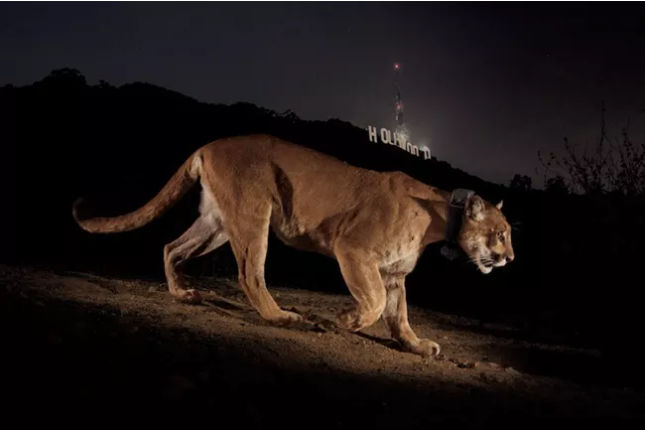
National Geographic / Steve Winter
A Big Cat with a Big Legacy
As wildlife lovers in L.A. mourn the loss of celebrity mountain lion P-022, a bigger picture about conservation emerges. P-022 was an ambassador for the cause of wildlife survival in an urban interface. Born in the Santa Monica Mountains more than a decade ago, he traveled east early in his life across the major freeways of Los Angeles to establish a home territory in Griffith Park. NPS biologists tracked his movements for 10 years via a GPS collar as part of a study to understand mountain lion behavior in an urban setting. In December 2022, P-022 started exhibiting unusual behaviors and attacking leashed pets. Subsequently, NPS and California Department of Fish and Wildlife staff captured P-022 for a health screening. After finding multiple injuries and pre-existing illnesses, the medical team at San Diego Zoo Safari Park recommended euthanasia under general anesthesia.P-022 inspired successful fundraising and subsequent construction of the Wallis Annenberg Wildlife crossing, a befitting legacy that will ensure wildlife have better-connected habitats and higher chances of survival in urban spaces. He showed us the challenges and possibilities for urban wildlife, and scientists will analyze his collar data for many years to come.
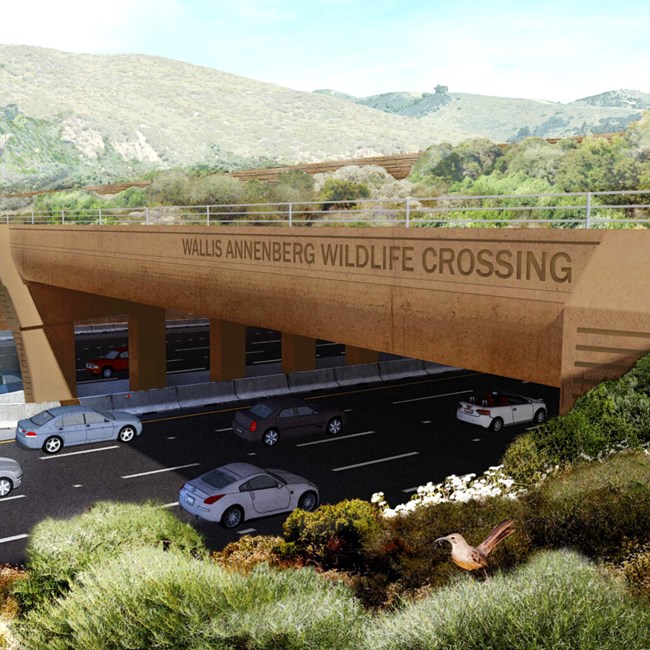
Annenberg Foundation
Why Did the Mountain Lion Cross the Road?
For over 25 years, NPS biologists and collaborators have documented the effects of habitat fragmentation caused by urban development on local wildlife in the Santa Monica Mountains and surrounding region. These studies indicated low genetic variation in bobcat, coyote, western fence lizard, wrentit, and mountain lion populations as a result of fragmentation. Mountain lions in this area are especially vulnerable and have some of the lowest levels of genetic diversity across the west, leading to physical effects similar to those of mountain lions in Florida before they nearly went extinct in the 1990s. The work by NPS biologists pointed to the importance of connectivity particularly along Highway 101, an almost impenetrable barrier for wildlife, and culminated in April 2022 when official ground was broken for the Annenberg Wildlife Crossing. The new crossing will reconnect an entire ecosystem between the Santa Monica Mountains and other large natural areas that have long been fragmented by the 101 Freeway.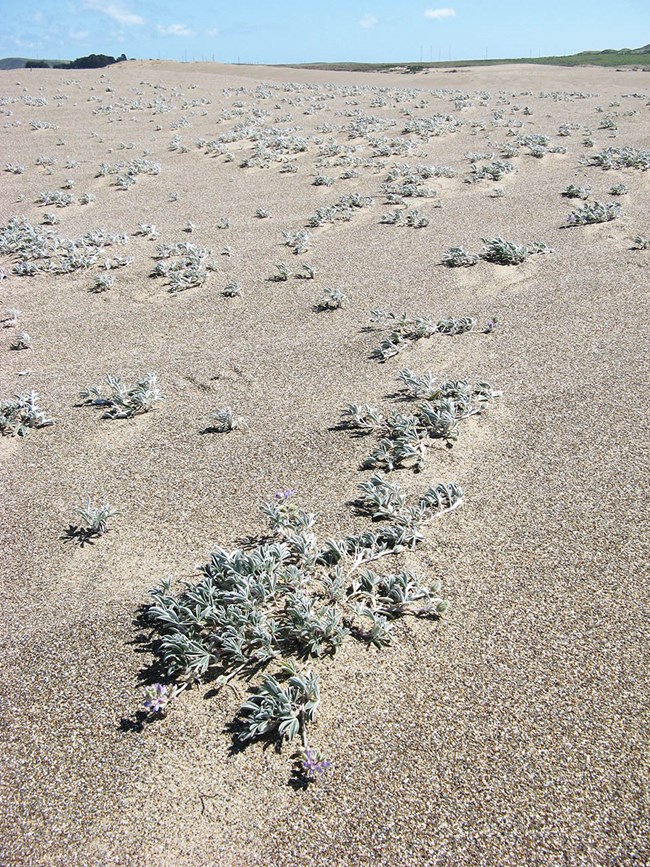
NPS
